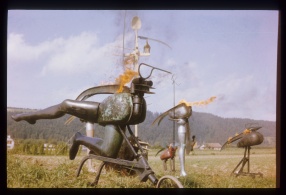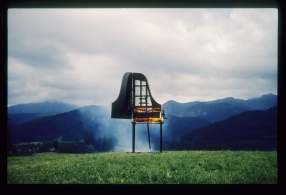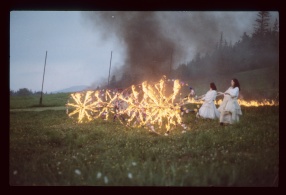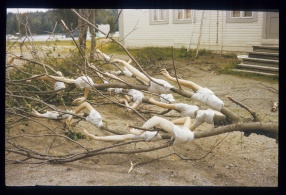Actions With Fire
Hasior's interest in fire is maybe an after-effect of his World War II experiences (see: A. Banach, "Hasior", Warszawa 1964). "I am guided by the will to reconstruct a very rich semantic layer of fire - sacral, mythic, poetic. Fire in an artwork never is, and, in any case, never should be a trivial phenomenon, deprived of exceptionally deep justification. I try to refute assumptions that fire fulfils only decorative or performance functions in my works. This must dramatic fire, such one whose the first name is the Element. [...] Formally, it is extremely difficult to run out of it once. By the way, so far we have used only a concept of fire itself and all phenomena referred to as light, shine, flash stem from fire and are connected with it. Diversity of electric light, candle light, light of polished surface, finely, light of celestial bodies - this all depends on the same group of matter, physically profuse. But, once again - perception of physical richness itself is not sufficient. It is also necessary to be able to recognise these phenomena as forces modelling mental states, emotional states, meanings. A candle in a man's hand provoke to notice that with the aid of this light we are looking for another human being; the same candle left on table is only a weak idea to light the apartment during a power blackout - however, it may be associated with waiting. The same candle inserted into a name day cake [sic!] will be a sign of ageing, the candle located on the turf of a grave gives out completely other emotions. Let's take it from the grave and set on a Christmas tree, and it radiates with joy and hope once again. At all times this is the same little flame. Noticing richness of meanings included in a concrete phenomenon is an obligation of the plastic working in various matters" - he said to Paweł Kwiatkowski in "Przekrój" ["Cross Section"] (1991, 19.09). The first work created with participation of fire was "Niobe" (1963), made of soap - purchased to the Art Museum in Łódź caused fire of a fixed exhibition.
Bibliography:
A. Banach, "Hasior", Warszawa 1964.
"Władysław Hasior. Europejski Rauschenberg?" ["Władysław Hasior. European Rauschenberg?"], ed. J. Chrobak, exhibition catalogue, MOCAK, Kraków 2014.




